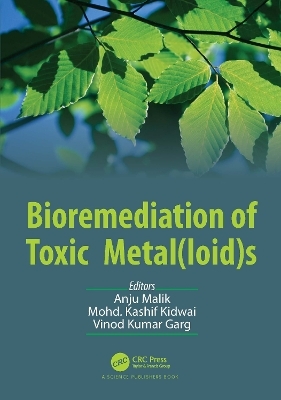
Bioremediation of Toxic Metal(loid)s
CRC Press (Verlag)
978-1-032-13577-9 (ISBN)
Dr. Anju Malik is presently working as Associate Professor and Chairperson at Department of Energy and Environmental Sciences, Chaudhary Devi Lal University, Sirsa, India. She has completed her M.Phil. and Ph.D. from School of Environmental Sciences, Jawaharlal Nehru University, New Delhi. She was awarded with Belgian Government fellowship under bilateral cultural exchange programme at University of Ghent, Belgium. Dr. Anju has also received research scholarships from University Grant Commission (UGC) and Council of Scientific and Industrial Research (CSIR), New Delhi, India. She has also worked in the past as Scientist under Indian Council of Forestry Research and Education, Dehradoon, India. With more than 17 years of research and teaching experience, her research interest is focused on trace elemental contamination, speciation and remediation. She is a life member of The Indian Science Congress Association, Kolkata, India. She has guided several M.Sc., M.Phil. and Ph.D. students. She has published research papers in various peer-reviewed national and international journals of repute and also published book chapters in edited books published by reputed international publishers. She is a reviewer of several international journals. Dr. Mohd. Kashif Kidwai is currently working as an Associate Professor in the Department of Energy and Environmental Sciences, Chaudhary Devi Lal University, Sirsa, Haryana, India. He has a Ph.D. in Environmental Sciences, University of Lucknow and National Botanical Research Institute (CSIR), Lucknow, India teaching various postgraduate courses and doctoral courses for more than 14 years in the Department of Energy and Environmental Sciences, Chaudhary Devi Lal University, Sirsa, Haryana, India. He has several publications into his credit including research and review articles in reputed national and international journals along with book chapters in edited books of reputed national and international publishers. He has participated and presented in various national and international conferences, etc., and is guiding both post graduate and doctoral students. He has been working on various environmental issues viz. water monitoring studies; agrochemical based phytotoxic studies of agriculturally important plants, development and application of fungal based biopesticides, etc. He is in process of conducting research on diverse environmental aspects. Prof. (Dr.) Vinod Kumar Garg is presently working as Professor at the Department of Environmental Science and Technology, Central University of Punjab, Punjab, India. He is a well-rounded researcher with more than 30 years of experience in leading, supervising, and undertaking research in the field of water, wastewater management, solid and Hazardous Waste Management. He and his research group are working on Water and Wastewater pollution monitoring and abatement, Solid Waste Management, Pesticide degradation, radioecology and Heavy Metal detoxification. He has published more than 200 research and review articles, 22 proceedings, and 6 editorials in peer-reviewed International and National journals of repute with more than citations 16000 and h-index 67. In addition, he has published 3 books and 15 book chapters and completed 10 sponsored research projects as Principal Investigator funded by various agencies and departments. He was awarded "Thomson Reuters Research Excellence – India Citation Awards 2012". He is an active member of various scientific societies and organizations including, the Biotech Research Society of India, the Indian Nuclear Society, etc.
Section 1: Fundamentals of Bioremediation of Toxic Metal(loid)s 1. Metal(loid)s: Sources, Toxicity and Bioremediation 2. Bioprecipitation as a Remediation Technique for Metal(loid)s Contamination from Mining Activities 3. Bioaccumulation of Metals in Lichens and Mosses: Understanding Atmospheric Deposition, Metal-induced Modifications and their Suitability as Biomonitors and Bioremediators 4. Phytoremediation: A Green Technology for Treating Heavy Metal Contaminated Soil 5. Water Hyacinth (Eichhornia crassipes): A Sustainable Strategy for Heavy Metals Removal from Contaminated Waterbodies 6. Bacterial Mechanisms for Metal(loid)s Remediation 7. Bioremediation Potential of Trichoderma species for Metal(loid)s 8. Trends in Waste Water Treatment using Phycoremediation for Biofuel Production 9. Lignocellulosic Waste as Adsorbent for Water Pollutants: A Step towards Sustainability and Circular Economy Section 2: Bioremediation of Specific Toxic Metal(loid)s 10. Bioremediation of Arsenic: A Sustainable Approach in Managing Arsenic Contamination 11. Phytoremediation of Uranium and Other Radionuclides in Soil and Water and Effects of Biogeochemical Conditions 12. Bioremediation Strategies for Removal of Chromium from Polluted Environment 13. Environmental Evidence and Behaviour of Mercury Emissions, Biogeochemical Cycle, and Remediation in Earth Systems Section 3: Biotechnological Strategies for Remediation of Toxic Metal(loid)s 14. Deciphering the Role of Metal Binding Proteins and Metal Transporters for Remediation of Toxic Metals in Plants 15. Remediation of Toxic Metal(loid)s: Biotechnological Strategies 16. Synthetic Biology Approaches for Bioremediation of Metals Section 4: Nanotechnology and Metal(loid)s Remediation 17. Bioremediation of Heavy Metals from Ecosystem Nanotechnological Perspectives 18. Mitigation of Arsenic Pollution by using Iron-based Nano-adsorbents Section 5: General Aspects/Case Studies on Bioremediation of Metal(loid)s 19. Restoration of Old Mining Sites Polluted by Metal(loid)s by using Various Amendments 20. Bioremediation of Mining Waste and Other Copper-containing Effluents by Biosorption 21. Remediation of Contaminated Chromite Mine Spoil by Biochar Application
| Erscheinungsdatum | 11.11.2022 |
|---|---|
| Zusatzinfo | 53 Tables, black and white; 19 Line drawings, color; 21 Line drawings, black and white; 16 Halftones, color; 4 Halftones, black and white; 35 Illustrations, color; 25 Illustrations, black and white |
| Verlagsort | London |
| Sprache | englisch |
| Maße | 178 x 254 mm |
| Gewicht | 920 g |
| Themenwelt | Naturwissenschaften ► Biologie ► Biochemie |
| Naturwissenschaften ► Biologie ► Genetik / Molekularbiologie | |
| Naturwissenschaften ► Chemie ► Technische Chemie | |
| Technik ► Bauwesen | |
| Technik ► Umwelttechnik / Biotechnologie | |
| ISBN-10 | 1-032-13577-8 / 1032135778 |
| ISBN-13 | 978-1-032-13577-9 / 9781032135779 |
| Zustand | Neuware |
| Informationen gemäß Produktsicherheitsverordnung (GPSR) | |
| Haben Sie eine Frage zum Produkt? |
aus dem Bereich


